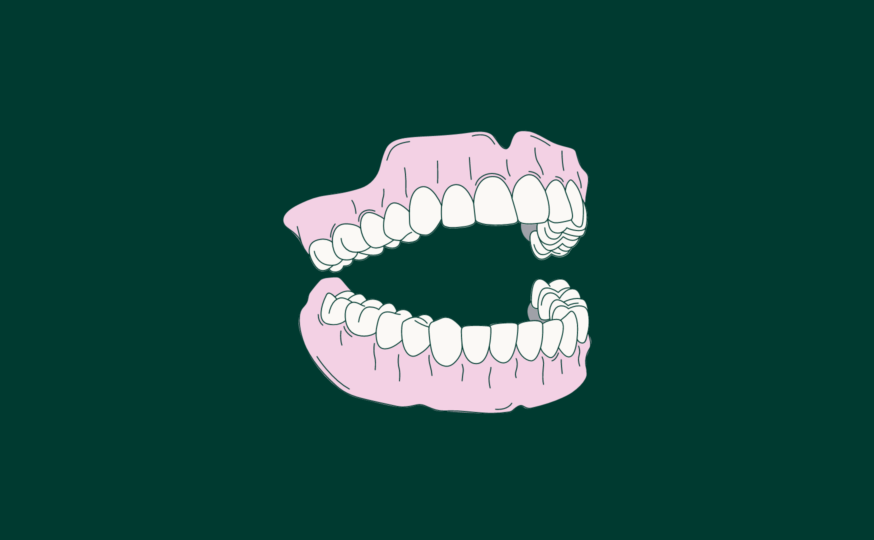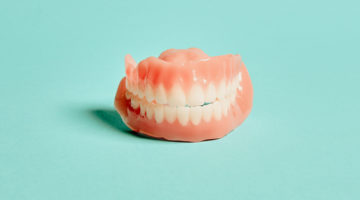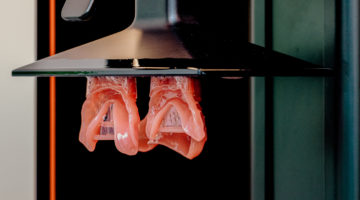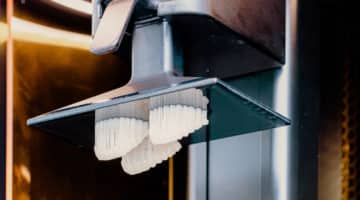“A maxillary denture’s purpose is to replace missing teeth,” says Chad Van Maele, a Dandy lab technician with over 16 years of experience fabricating dentures. Unlike most other lab techs, Van Maele has worked chairside with practitioners in dental clinic settings; he’s born firsthand witness to the life-changing effects of proper dental restoration. “It gives [patients] their smile back,” he says, adding, “It gives them back the ability to chew solid food and, from a phonetic point of view, maxillary dentures play a huge role [in forming fricative consonant sounds]. Smile, phonetics, and eating are the big three that a maxillary denture is going to restore for that patient.”
Yet despite all of the benefits afforded by quality maxillary dentures, the traditional process they necessitate might just make some patients (and even practitioners!) think twice. Uncomfortable impressions subject to error, fragile molds, gratis follow-up appointments for rims, try-ins, color matching, articulating; shipping and waiting before more follow-ups and more shipping and more waiting–and that’s not include the inevitable repairs and remakes–the potentially monthslong ping-ponging can test both doctors’ and patients’ patience.
Good news: digital dentistry has revolutionized everything about maxillary dentures. Now, a patient goes from initial scan to final prosthesis in as few as two visits. And not only is the entire process more comfortable and convenient for the patient, not only is every step of the way from initial scan to fabrication of the finished restoration faster; the final product is more durable, more accurate, and more affordable than traditional methods.
Taking impressions for maxillary dentures
It all starts with an initial scan using an intraoral scanner. Using painless light pulses, the scanner instantly maps the teeth, gums, and bite in minute detail, all in mere minutes. Using this data, Dandy’s Chairside software instantly constructs a color, fully-manipulable 3D model of the patient’s entire oral cavity. If you’re looking for the “wow” factor, you can’t do much better than enabling your patient to see their present dentition and visualizing their treatment outcome.
Compared to the alternatives, digital impressions are more accurate, more comfortable for patients, and more streamlined than traditional methods. And because electronically transmitting complete scan data to the lab is as easy as a few mouse clicks, digital impressions eliminate the risks posed by human error; drops, warps, inclusions, and logistical SNAFUs are all history.
Your patient’s scan is also saved securely on Dandy’s servers, meaning that, in the event of a denture’s loss or damage, ordering an identical replacement takes about as much time as sending an email—no patient appointment required.
Maxillary denture material selection
What is considered the “best” denture material? That depends on the use-case and the patient’s preferences. But what’s clear is that the flexibility of digital dentistry means that you and your patients have many excellent options. Considering the refined workflows and timelines touted by digital dentistry, you might be asking: what are Dandy’s dentures made of and how do they compare to traditional dentures?
Dandy offers two choices for maxillary complete dentures: Signature 3D printed Denture and Aesthetic Milled Denture.
Dandy’s Signature 3D Printed Denture
Both the base and teeth of our Signature 3D printed denture are constructed from formulations of Dentsply Sirona’s cutting edge acrylic resin, Lucitone. This advanced material experiences minimal water retention and material loss, and has higher tensile and flexural strength than the competition. Plus, Van Maele explains, Lucitone is “a body activated material–it builds in strength when it’s in the patient’s mouth; it becomes twice as strong.” Additionally, he says, the 3D printed construction addresses a common cause of denture repairs. “The way the [Dandy Signature 3D printed Denture] teeth are designed monolithically means that you no longer have teeth that will pop out of the denture–it’s simply impossible with these digital dentures.” But the 3D printed material does have some minor drawbacks inherent to the 3D printing process, namely monotone base color and a lack of subsurface venous detail. But that, Van Maele says, is about it. “The advantages of the printed material is that the denture comes to you faster than milled (seven business days instead of nine), it’s a little more cost effective (it’s $100 cheaper to go with printed material), and that Lucitone is a bit stronger [than milled.]”
Dandy’s Aesthetic Milled Denture
Dandy’s Aesthetic Denture is milled–rather than being built layer by layer as in 3D printing, the milled maxillary complete denture is, for all intents and purposes, carved from a block of solid material. The base is made from Ivoclar Ivotion and the teeth from multi-layer polymethyl methacrylate (PMMA). These exceptionally strong and durable materials support an incredible level of realism and detail that are not currently achievable with 3D printing technology. With Dandy’s milled denture, patients who naturally sport more visible gingiva will find their denture faithfully recreates their smile replete with multifaceted color and subsurface venous detail. “Basically, it’s the exact inverse of [the 3D printed denture’s pros/cons] for the milled material: the pro is that the milled has the fiber veins and more realistic color, but the cons are that it costs $100 more and takes two extra business days (nine instead of seven) to get the denture to you. And it’s not a body activated material, so it’s not quite as strong as the printed material.“
Both materials have their advantages and drawbacks for maxillary dentures, but compared to traditional materials, either yields a superior product in less time for lower cost. “These new materials have advanced to be stronger than analogue (non-digital) material,” says Van Maele… “Stronger material, better design, faster, and many times more cost effective than analog.”
Adjusting maxillary dentures
It may be the case that a patient’s new maxillary denture is a remake of a traditional hand-fashioned appliance to which they’re accustomed. Or maybe it’s their very first maxillary complete denture and they’re refining their preferences in real-world use-cases. Either way, normal wear-and-tear and post-extraction bone loss and the unforeseen all mean that no patient is likely to go the entire lifespan of their prosthesis with zero adjustments.
With traditional dentures, inferior materials meant lower bond strength, higher water retention, discoloration, and breakage. “When a patient would come in with a broken denture, they’ve lost their ability to talk correctly, smile and eat until that denture can be fixed,” says Van Maele. “For many dentists, this is not a quick thing… 90% of dentists out there. The experience is that they mail it off to a lab and maybe a week or two later they get it back. In the meantime, that patient is just without until it gets fixed.” If a patient wasn’t coming in for a simple re-line you might be looking down the barrel of new bite registration, scans, VDO adjustment; a complete remake from scratch. Dentists, Van Maele says, “may be eating the cost of that repair because… the lab’s gonna charge a repair fee to the doctor one way or the other, whether that doctor charges that patient or not… Sometimes the dentist will just flat out eat that cost.”
“Introducing digital dentistry to your practice will give patients a better experience with fewer appointments, and a better product with fewer adjustments,” says Van Maele. What does he mean? Not only are digital maxillary dentures stronger and more durable than traditional and therefore less likely overall to require fixes, not only is fabrication quick, not only are 3D printed materials less expensive than traditional overall, fine-tuning the fit of an existing denture couldn’t be easier:
- Patient arrives with their existing denture
- They insert it and you apply wash to make adjustments
- You or an assistant perform intraoral scans and a 360 extraoral pass
- You upload the information to Dandy’s lab software including all patient feedback
- In about a week, the new maxillary denture arrives at your office and the patient returns.
“When the patient has an existing denture, [the fabrication process] boils down to just two appointments because we are simply able to capture more information.” Van Maele says. “That’s the biggest impact I’d say for [Dandy’s] patients and our doctors: eliminating all those–I don’t wanna say extra appointments because they’re not extra for analog–but basically, you’re accomplishing more in those appointments with digital.”
Maxillary complete dentures with Dandy
Maxillary dentures can be a long complex process with major implications for patients’ health and self-esteem. Introducing digital dentistry to your practice can shorten appointments times, streamline your workflow, and increase patient comfort all while yielding industry-leading products.
All of that is incredible, but it isn’t the Dandy difference.
“The true Dandy difference–that no other lab is doing–is our level of support,” Van Maele says. “We don’t just give you a scanner and then say ‘good luck figuring that out!’ We give you training, and then beyond training, we give you support with technicians that’ll log in while you have a patient in-chair… Being at Dandy has given me a real opportunity,” he continues. “Because we’re digital, I’m able to–in a very kind of real sense–be in 1,000 different offices at once, so if [a practitioner is] having trouble, I can log into their computer and we can discuss the case, or I can check the scans. With analog dentistry, that might require a plane ride! With Dandy, I can more greatly impact more doctors’ lives and thereby more patients’ lives… that’s just something no other lab has. Dandy’s philosophy about the doctor/lab relationship is that it’s not a business relationship—we’re partners. We want to share their successes. That’s the Dandy difference.”
Partnership with Dandy means that you can offer maxillary complete dentures, possibly in just two appointments. Learn more about Dandy’s 2-appointment denture offering here!



